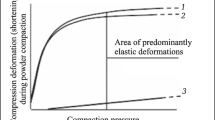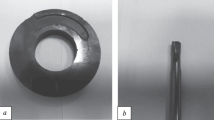The types of additive technologies and the prospects for their use in the fabrication of products from silicon carbide ceramic materials are considered. The most popular for obtaining parts of complex configurations are additive technologies such as stereolithography, photocuring, inkjet printing, layer-by-layer 3D printing by extrusion of ‘inks,’ three-dimensional printing, selective laser sintering, selective laser melting, lamination method, layer-by-layer deposition method.




Similar content being viewed by others
References
E. N. Kablov, “Present and future of additive technologies,” Metally Evrazii, No. 1, 2 – 6 (2017).
E. N. Kablov, “Additive technologies — main thrust of the national technology initiative,” Intellekt i Tekhnol., No. 2(11), 52 – 55 (2015).
C. W. Hull, Apparatus for Production of Three-Dimensional Objects by Stereolithography: US Patent 4.575.330 (1986).
J. Deckers and J.-P. Kruth-Vleugels, “Additive Manufacturing of Ceramics: a Review,” J. Ceram. Sci. Technol., 5(4), 245 – 260 (2014).
V. E. Nizovtsev, D. A. Klimov, M. I. Stupenkov, and E. N. Bredikhina, “Advantages of additive technologies as alternatives to conventional technologies,” in: Proceedings of the 4th International Conference on Additive Technologies: Present and Future. Moscow, March 30, 2018 [in Russian], Moscow (2018), pp. 229 – 234.
V. E. Nizovtsev, D. A. Klimov, M. I. Stupenkov, et al., “Prospects for the use of additive technologies for manufacturing parts and assemblies from ceramic composite materials,” in: Proceedings of the 4th International Conference on Additive technologies: Present and Future. Moscow, March 30, 2018 [in Russian], Moscow (2018), pp. 333 – 340.
E. N. Kablov, “Modern materials — the basis of innovative modernization of Russia,” Metally Evrazii, No. 3, 10 – 15 (2012).
M. I. Alymov, “Consolidated powder nanomaterials: a review,” Aviats. Mater. Tekhnol., No. S4, 34 – 39 (2014); https://doi.org/10.18577/2071-9140-2014-0-s4-34-39.
A. S. Chainikova, L. A. Orlova, N. V. Popovich, et al., “Dispersion-strengthened composites based on glass/glass-ceramic matrices: properties and applications: review,” Aviats. Mater. Tekhnol., No. 3, 45 – 54 (2014); https://doi.org/10.18577/2071-9140-2014-0-3-45-54.
D. V. Grashchenkov, “Strategy for the development of non-metallic materials, metal composite materials and thermal protection,” Aviats. Mater. Tekhnol., No. S, 264 – 271 (2017); https://doi.org/10.18577/2071-9140-2017-0-S-264-271.
A. P. Garshin, V. M. Gropyanov, G. P. Zaitsev, and S. S. Semenov, Ceramics for Mechanical Engineering [in Russian], Nauchtehlitizdat, Moscow (2003)
J. Maurath and N. Willenbacher, “3D printing of open-porous cellular ceramics with high specific strength,” J. Eurp. Ceram. Soc., 37(15), 4833 – 4842 (2017).
Y. Li, Y. Hu, W. Cong, et al., “Additive manufacturing of alumina using laser engineered net shaping: Effects of deposition variables,” Ceram. Int., 43(10), 7768 – 7775 (2017).
C. Polzin, D. Günther, and H. Seitz, “3D printing of porous Al2O3 and SiC ceramics,” J. Ceram. Sci. Technol., 6(2), 141 – 146 (2015).
R. He, G. Dinga, and K. Zhang, “Fabrication of SiC ceramic architectures using stereolithography combined with precursor infiltration and pyrolysis,” Ceram. Int., 45, 14006 – 14014 (2019).
H. Zhong, X. Yao, Y. Zhu, et al., “Huang preparation of SiC ceramics by Laminated Object Manufacturing and pressureless sintering,” J. Ceram. Sci. Technol., 6(2), 133 – 140 (2015).
L. Weisensel, N. Travitzky, H. Sieber, and P. Greil, “Laminated object manufacturing (LOM) of SiSiC composites,” Adv. Eng. Mater., 6(11), 899 – 903 (2004).
H. Windsheimer, N. Travitzky, A. Hofenauer, and P. Greil, “Laminated object manufacturing of preceramic paper derived Si–SiC composites,” Adv. Mater., 19(24), 4515 – 4519 (2007).
S. Meyers, L. De Leersnijder, J. Vleugels, and J.-P. Kruth, “Direct laser sintering of reaction bonded silicon carbide with low residual silicon content,” J. Eurp. Ceram. Soc., 38(11), 3709 – 3717 (2018).
W. Zhu, H. Fu, Z. Xu, et al., “Fabrication and characterization of carbon fiber reinforced SiC ceramic matrix composites based on 3D printing technology,” J. Eurp. Ceram. Soc., 38(14), 4604 – 4613 (2018).
M. Pelanconi, P. Colombo, and A. Ortona, “Additive manufacturing of silicon carbide by selective laser sintering of PA12 powders and polymer infiltration and pyrolysis,” J. Eurp. Ceram. Soc., 41, 5056 – 5065 (2021).
H. Exner, M. Horn, A. Streek, et al., “Laser micro sintering: A new method to generate metal and ceramic parts of high resolution with sub-micrometer powder,” Virtual and Physical Prototyping, 3(1), 3 – 11 (2008).
E. N. Kablov, “Innovative developments of FSUE “VIAM” of the State Scientific Center of the Russian Federation for the implementation of the ‘Strategic Directions for the Development of Materials and Technologies for Their Processing for the Period until 2030’,” Aviats. Mater. Tekhnol., No. 1, 3 – 33 (2015); https://doi.org/10.18577/2071-9140-2015-0-1-3-33.
This work was performed as part of the implementation of a comprehensive scientific direction 14.1: Structural ceramic composite materials (“Strategic directions for the development of materials and technologies for their processing in the period up to 2030”) [23].
Author information
Authors and Affiliations
Corresponding author
Additional information
Translated from Steklo i Keramika, No. 11, pp. 37 – 42, November, 2022.
Rights and permissions
Springer Nature or its licensor (e.g. a society or other partner) holds exclusive rights to this article under a publishing agreement with the author(s) or other rightsholder(s); author self-archiving of the accepted manuscript version of this article is solely governed by the terms of such publishing agreement and applicable law.
About this article
Cite this article
Kachaev, A.A., Vaganova, M.L., Lebedeva, Y. et al. Use of Additive Technologies for Making Silicon Carbide Ceramic Materials: A Review. Glass Ceram 79, 462–465 (2023). https://doi.org/10.1007/s10717-023-00533-5
Received:
Published:
Issue Date:
DOI: https://doi.org/10.1007/s10717-023-00533-5




